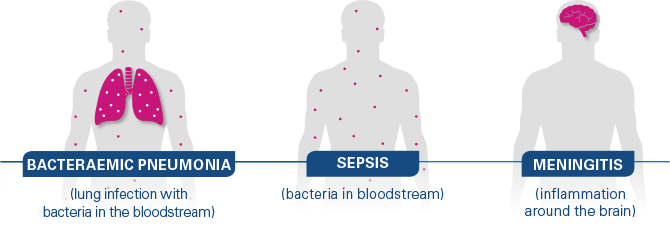Who is at risk?
- Asthma
- Chronic cerebral spinal fluid (CSF) leak
- Chronic neurologic condition that may impair clearance of oral secretions
- Cochlear implants (including those children who are to receive these hearing devices)
- Chronic heart or lung disease
- Diabetes
- Spleen not working or has been removed (asplenia, functional or anatomic)
- Sickle cell disease or other conditions that affect hemoglobin function
- Chronic liver disease (including hepatic cirrhosis due to any cause)
- Leukemia and lymphoma (and other malignant neoplasms)
- Solid organ or islet transplant (candidate or recipient)

The National Advisory Committee on Immunization (NACI) recommends that all children and adolescents with asthma (ages 2-18) should be vaccinated against IPD with PNEU-C-13.
Learn more about the recommendation here.
High-risk children and adolescents 6-17 years should be vaccinated
Children and adolescents at high risk of IPD who have not previously received the PNEU-C-13 vaccine should receive a single PNEU-C-13 dose.
If a child or adolescent at high risk of IPD has not previously received the PNEU-P-23 vaccine, one dose of the PNEU-P-23 vaccine should also be administered at least 8 weeks after the PNEU-C-13 vaccine.
What is invasive pneumococcal disease?

How does it work?
Vaccines teach our bodies to recognize and respond to viruses and bacteria, by making products called antibodies that help fight the disease. Our immune system can remember and fight them if they attack in the future.
The Prevnar 13 vaccine works by helping the body make its own antibodies, which helps protect you against diseases caused by 13 types of the bacteria Streptococcus
pneumoniae.

Prevnar 13 safety information
Prevnar 13 should not be used if your child is allergic (hypersensitive) to the active substances, to any other ingredients, or to any other vaccine that contains diphtheria toxoid.
- If your child has any present or past medical problems after any dose of Prevnar 7 or Prevnar 13
- If your child is sick with a high fever
- If your child has any bleeding problems
Prevnar 13 will only protect against diseases caused by the types of Streptococcus pneumoniae covered by the vaccine. As with any vaccine, Prevnar 13 will not protect 100% of those who receive the vaccine.
Following vaccination with Prevnar 13, children and adolescents may experience redness, pain, tenderness (including impaired movement), swelling or hardness at the vaccination site, fever, irritability, drowsiness, restless sleep, decreased appetite, hives, diahrrea, vomitting and rash.
Talk to your doctor, pharmacist or nurse about vaccination with Prevnar 13.
What is invasive pneumococcal disease (IPD)?
IPD occurs when bacteria called Streptococcus pneumoniae invades body sites that normally should not contain bacteria, such as the lining around the brain (meningitis), blood (sepsis), or lungs and blood (bacteraemic pneumonia).
IPD primarily affects:
- young children
- individuals with certain risk factors such as lifestyle or underlying medical conditions, and
- anyone 65 or over
In young children, bacteraemia accounts for 50 to 70% of all episodes of IPD, followed by pneumonia (15 to 25%) and meningitis (4%).
In adults, bacteraemic pneumonia accounts for 50 to 80% of all episodes of IPD.
“Invasive” disease means germs invade parts of the body that are normally germ-free.
Meningitis
Meningitis is inflammation of the covering of the brain and spinal cord and is generally caused by an infection.
Symptoms include:
- Stiff neck
- Fever and headache
- Pain when looking into bright lights
- Confusion
In babies, meningitis may cause poor eating and drinking, low alertness and vomiting.
COMPLICATIONS
Of children younger than 5 years old who get pneumococcal meningitis:
- About 1 out of 15 will die from the infection
- Others may have long-term problems, such as hearing loss or developmental delay
The chance of death increases among elderly patients.

Bacteraemia and sepsis
Bacteraemia and sepsis are infections where bacteria enter the bloodstream.
Symptoms include:
- Fever
- Chills
- Low alertness
COMPLICATIONS
About 1 out of 100 children younger than 5 years old with bacteraemia infection will die from it.
The chance of death is increased among elderly patients.

Bacteraemic pneumonia
Bacteraemic pneumonia is inflammation of one or both of the lungs with pneumococcus bacteria invading and entering the bloodstream.
Bacteraemic pneumonia accounts for 15-25% of the cases of IPD in young children and 50-80% of cases in adults.
- Fever and chills
- Cough
- Rapid breathing or difficulty breathing
- Chest pain
Older adults with pneumonia may experience confusion or low alertness, rather than the more common symptoms listed above.
COMPLICATIONS
- Infection of the space between membranes that surround the lungs and chest cavity (empyema)
- Inflammation of the sac surrounding the heart (pericarditis)
- Blockage of the airway that allows air into the lungs (endobronchial obstruction)
- - lung collapse (atelectasis)
- - collection of pus (abscess) in the lungs
Prevnar 13 is not indicated to reduce complications of IPD, including death, neurological complications or hearing loss.

How does it spread?

Can IPD be treated?
IPD can be treated with antibiotics.
Although Prevnar 13 can help protect against diseases such as meningitis, sepsis, bacteraemia and bacteraemic pneumonia caused by 13 serotypes of the bacteria Streptococcus pneumoniae, it is not intended to be used in the treatment of active infection.
As with any vaccine, Prevnar 13 will not protect 100% of those who receive the vaccine.









